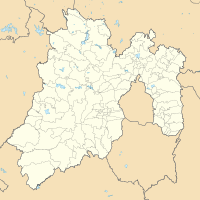Texcoco de Mora
| Texcoco | ||
|---|---|---|
|
Coordinates: 19 ° 32 ′ N , 98 ° 54 ′ W Texcoco on the map of Mexico
|
||
| Basic data | ||
| Country | Mexico | |
| State | México | |
| Municipio | Texcoco | |
| Residents | 105,165 (2010) | |
| City insignia | ||
| Detailed data | ||
| height | 2250 m | |
| Post Code | 56100 | |
| prefix | 595 | |
| Time zone | UTC −6 | |
| City Presidency | Amado Acosta García, PRI | |
| Website | ||
Texcoco (Nahuatl Tetzcohco , meaning unclear, colonial Tezcuco ), with the full official name Texcoco de Mora is a city in Mexico in the state of México east of Mexico City . Texcoco has a population of around 105,000 and is located on the northeastern shore of Lake Texcoco, which has now dried up .
history
In pre-Columbian times, Texcoco was an independent city-state of the Acolhua , a Nahua ethnic group (a people who spoke Nahuatl ). Nezahualcóyotl , the king of the Acolhua, who was also a respected poet , philosopher and patron , ruled the city . Early on he allied himself with Tenochtitlán (today's Mexico City ), rose as a member of the Aztec Triple Alliance to become the second most politically important city in the Aztec Empire and received 40 percent of the tribute raised by the empire. The city was a center for education and culture and had a famous library of works from older Mesoamerican civilizations. This large library collected the most important works from all over the Aztec empire and was burned to the ground by the Spanish conquistadors because they regarded its contents as pagan and anti-Christian.
Nezahualpilli , ruler of the city of Texcoco, died in 1515, before the arrival of the Spaniards. Moctezuma , the ruler of Tenochtitlán intervened in the line of succession and appointed Cacama , one of the sons of Nezahualpilli, as the new ruler of Texcoco. Ixtlilxochitl II , a half-brother of Cacama felt that he had been left out and robbed of his throne. With some of his followers he withdrew and rebelled against his half-brother. This rebellion continued when the Spaniards were Moctezuma's guests in Tenochtitlán.
After the Spaniards had captured Moctezuma, Cacama drove the overthrow of the Aztec ruler and wanted to take military action against Cortés. But he heard about the plans. He had Cacama captured and chained him. In his place he put a brother of Cacama's on the throne of Texcoco. His name was Cuicuitzcatl, and Ixtlilxochitl felt left out one more time.
After his loss-making retreat in the Noche Triste , Hernán Cortés waged war against the Aztecs. Cuicuitzcatl fought on the side of Tenochtitlán against the Spaniards in this war. When Cortés occupied Texcoco almost without a fight, he fled the city with his followers. Shortly afterwards, Cortés summoned Ixtlilxochitl and placed him on the throne of Texcoco. The new ruler proved to be a loyal friend of the conquistadors and an enemy of the Aztecs. At the Battle of Tenochtitlán in 1521, many Texcoco warriors fought on the side of the Spaniards.
From 1827 to 1830 Texcoco was the capital of the state of México.
Attractions
The murals by Diego Rivera in the Universidad Autónoma Chapingo are worth seeing . Rivera painted a chapel in the former hacienda, his “Sistine Chapel” so to speak, but with socialist motifs.
Then the Museo de Paleontología de Tocuila .
Excursion destinations are the ruins of the palace of Nezahualcóyotl on the Cerro del Tetzcotzingo , with the so-called bath of the queen and a still clearly recognizable, complex system of water pipes.
Web links
supporting documents
- ^ Hanns J. Prem : Die Azteken-Geschichte-Kultur-Religion , Verlag CH Beck, page 24
- ^ Bernal Díaz del Castillo: History of the Conquest of Mexico, 1988, p. 290
- ^ Bernal Díaz del Castillo: History of the Conquest of Mexico, 1988, p. 394



